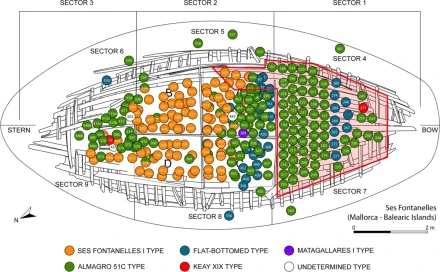History
The Late Roman shipwreck found at Ses Fontanelles lays just 65 m off the coast and just two meters depth in a very busy area of the coast, covering an area of approximately 12 m long by 5 m wide.
The excellent state of preservation of the hull and the cargo, including amphorae with painted inscriptions (tituli picti), and its location in shallow waters offshore of one of the main touristic beaches of the island Mallorca makes this a unique finding in the Mediterranean.
Ship remains
The analysis of the wood shows, as known in Roman shipbuilding, a clear selection of forest resources. The shipbuilders used pine for longitudinal parts of the hull, while for the small pieces related to the assemblage system (pegged, mortise and tenons) and subjected to a great stress they selected harder woods mainly Cupressaceae, Olea europaea, and Laurus nobilis.
The excellent state of preservation helps to reconstruct the composition and disposition of the cargo. The hull was divided into horizontal sections by vertical bulkheads, which were used to organize the cargo inside the hold. It is also important to emphasize that the hull is very well preserved from bow to stern (approximate height of 1.5 m). The interim examination of the shipbuilding confirmed that the vessel belongs to the shell-first with mortise and tenons assemblage tradition, being a typical example of western Roman imperial naval architectural type.
Date
The ship and amphorae are at present dated to the Late Roman periode. We know that it has to be at least AD 320. a coin of that year from Constantine was found in the step mast. a precise terminus post quem. It is probably that the boat sunk in the mid-fourth century AD.

Plan of the shipwreck with the positioning of the amphorae of the cargo documented during the excavation process
Cargo
The ship transported a relevant cargo of products packaged in amphorae, carrying a cargo of fish sauce (liquaminis flos), oil, and wine, transported in three main types of amphorae.
This, together with the preservation of an impressive quantity of inscriptions depicted on the amphorae (tituli picti), makes this site a unique example in the Mediterranean and an excellent case for the study of commercial dynamics in Late Antiquity.
The results of the combination of the petrographic analysis, the study of the ichthyofauna and the organic residue analysis suggest that the boat probably departed from the area of Cartagena in the southeastern part of the Iberian Peninsula.
Lading en herkomst
Het Ses Fontanelles schip vervoerde een lading producten verpakt in amforen, o.a. vissaus (liquaminis flos), olie en wijn, vervoerd in drie hoofdtypen amforen. De amphorae waren voorzien van eigendom inscripties (tituli picti). Waarvan een groot deel bewaard is gebleven afgebeeld op de amforen.
De resultaten van de combinatie van de petrografische analyse, de studie van de ichthyofauna en de organische residuanalyse suggereren dat de boot waarschijnlijk vertrok uit het gebied van Cartagena in het zuidoostelijke deel van Spanje.
Description
Status
The Consell de Mallorca, holder of the competences in matters of Historical Heritage on the island, has decided, in addition to proceeding with the integral excavation and recovery of the furniture, to propose the possibility of extracting the hull of the boat to guarantee its conservation and its future musealization and enhancement.
References
- Miguel Ángel Cau Ontiveros.
Ses Fontanelles shipwreck. - Cau-Ontiveros, M.Á., Bernal-Casasola, D., Pecci, A. et al (2024).
Multianalytical approach to the exceptional Late Roman shipwreck of Ses Fontanelles (Mallorca, Balearic Islands, Spain.
Archaeol Anthropol Sci 16.
pp 58.